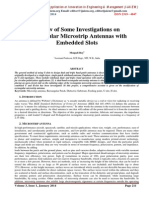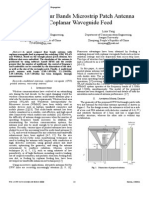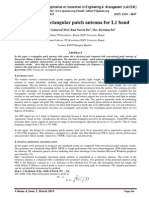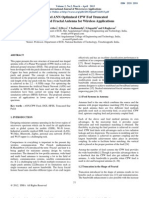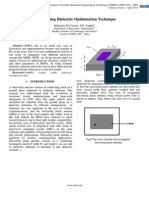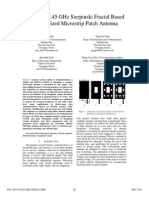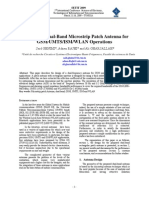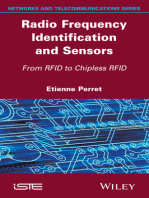Performance Analysis of Microstrip Patch Antenna by Varying Slot Size For UMTS Application
Performance Analysis of Microstrip Patch Antenna by Varying Slot Size For UMTS Application
Uploaded by
siva1427Copyright:
Available Formats
Performance Analysis of Microstrip Patch Antenna by Varying Slot Size For UMTS Application
Performance Analysis of Microstrip Patch Antenna by Varying Slot Size For UMTS Application
Uploaded by
siva1427Original Title
Copyright
Available Formats
Share this document
Did you find this document useful?
Is this content inappropriate?
Copyright:
Available Formats
Performance Analysis of Microstrip Patch Antenna by Varying Slot Size For UMTS Application
Performance Analysis of Microstrip Patch Antenna by Varying Slot Size For UMTS Application
Uploaded by
siva1427Copyright:
Available Formats
2014 Fourth International Conference on Communication Systems and Network Technologies
Performance analysis of Microstrip Patch Antenna by
varying slot size for UMTS Application
1
Janabeg Loni, 2Shahanaz Ayub, 3Vinod Kumar Singh
1
M.Tech Scholar, UPTU Lucknow
2
B.I.E.T. Jhansi, U.P. India
S.R.Group of Institution, Jhansi, India
jloni100774@gmail.com, singhvinod34@gmail.com
3
as the thickness and dielectric constant (r) of the substrate
used to separate the patch and the ground plane of the patch,
is determined on the basis of operating frequency of the
patch antenna. If the operating frequency is lowered then the
area of the patch is increased (whenever the substrate is not
changed). The design of Microstrip antenna is vital study for
todays Wireless communication system to achieve higher
radiation pattern, highly directional beam and larger
bandwidth [10]- [17].
In this study, the design and analysis of slotted microstrip
patch antenna is introduced. It is designed on glass epoxy
substrate which is best suitable for UMTS applications.
Abstract- The main focus of this paper is to study the
enhancement in bandwidth by varying the slot size in
microstrip patch antenna. A wide band coaxial probe feed dual
triangle slotted microstrip patch antenna has been simulated
on IE3D software to give a wide bandwidth of 31.34% and
maximum antenna efficiency of about 98%.The characteristics
of proposed microstrip antenna such as efficiency, gain and
directivity has simulated and studied in this paper and the
antenna is designed to operate in the frequency range of 1.8242.502 GHz. Here five different slot sizes are taken and it is
concluded that as we increase the slot size the bandwidth
increases.
Keywords: Coaxial probe, Slotted patch, UMTS, Wideband
MSA.
I.
II. ANTENNA DESIGN
In this paper the basic structure is as shown in fig1 is a
rectangular patch of dimension 27.16 mm x 35.2 mm and
ground plane length and width is 36.76 mm x 44.8 mm and
the rectangular slot of length and width size is 25mm x
3.2mm.The dual triangle slotted microstrip patch antenna is
designed. The operating frequency considered here is 2.6
GHz. The characteristics of proposed antenna such as return
loss (RL), VSWR, and bandwidth (BW) of the proposed
antenna have been investigated. The numerical study has
been done by using Zeland IE3D electromagnetic simulator.
INTRODUCTION
Microstrip patch antenna is a type of microwave antenna and
attracted widespread interest due to their small section plane,
light weight and low profile. They are simple to manufacture
and are easily integrated with circuits [1]-[2]. It is used for
GPS/DCS/PCS/UMTS/WLAN and WiMax Applications. It
consists of a radiating patch on one side of a dielectric
Substrate and a ground plane on the other side. Radiation
from MSA can occur from the fringing fields between the
periphery of the patch and the ground plane. By increasing
the width W of the patch, substrate thickness and decreasing
the r the fringing fields from the patch can be enhanced
which accounts for radiation.
Therefore unlike the
microwave integrated circuits (MIC) applications MSA uses
microstrip patches with longer width and substrate with
lower r [3]-[4]. The conducting patch and the ground plane
are separated by a low loss dielectric material called a
substrate. The shape of the patch can be arbitrary. It may be
square, rectangular, dipole, circular, elliptical, triangular,
disc sector, circular ring; ring sector. The most popular
shapes however, are the rectangle and circle. A coaxial line
or strip line can be used to carry electromagnetic energy to
the patch. Regardless of which feed line is used, the energy
is first carried to the region under the patch. This region acts
like a resonant cavity with open circuits on all sides. At this
point the energy is either reflected back along the same feed
line or it leaks out and radiates into free space resulting in an
antenna [5]-[8]. The dimensions such as size, shape, as well
978-1-4799-3070-8/14 $31.00 2014 IEEE
DOI 10.1109/CSNT.2014.9
TABLE 1
ANTENNA DESIGN PARAMETERS
Parameter
Value
1.6mm
4.4
Wg
44.8mm
Lg
36.76mm
35.2mm
27.16mm
W1
3.2mm
L1
25.0mm
Fig.3. Efficiency Vs Frequency of proposed microstrip antenna for
optimum bandwidth
Fig.1. Geometry of proposed microstrip antenna for optimum bandwidth
The calculations are based on transmission line model. The
width and length of the microstrip patch have been
calculated by using following equations (1)-(4).
c
(1)
W
2 f ( r 1) / 2
The effective length (Leff) of the patch can be calculated with
the help of equations (3) and (4).
eff
r 1 r 1
2
h
1 10 W
1
2
(2)
Fig.4. Directivity Vs Frequency of proposed microstrip antenna for
optimum bandwidth
eff 0 .300 W 0 . 262
l
h
0 . 412
h
eff 0 . 258 W 0 . 813 (3)
h
By using above equations we can find the value of actual
length of the patch as,
L
c
2 f eff
2l
(4)
Fig.5. Gain Vs frequency of proposed microstrip antenna for optimum
bandwidth
III. RESULT AND DISCUSSION
The proposed antenna has been simulated and optimized by
IE3D software and results are presented. As shown in the
figure 2, the maximum achievable bandwidth is 31.34%
which is better compare to design reported in [5]. Figure 3
shows the simulated total efficiency of the patch antenna.
Fig2. Simulated Return loss Vs frequency of proposed microstrip antenna
for optimum bandwidth
The figure indicates high antenna efficiency over the
operational frequency and it is around an average of 98%,
which is best suitable for UMTS (1.92 GHz-2.17 GHz)
application. Figure4 and Figure5 shows Directivity & Gain
Vs Frequency plot of proposed microstrip antenna.
IV. BANDWIDTH STUDY OF DESIGNED ANTENNA
FOR DIFFERENT SLOT LENGTHS
Fig 7 shows the design of microstrip patch antenna of
slot length L1 =15.0 mm having return Loss bandwidth of
about 22.10% which is shown in Fig 8. Fig 9 shows the
design of microstrip patch antenna of slot length L1 =18.5
mm having return Loss bandwidth of about 24.16% which is
shown in Fig 10. Fig 11 shows the design of microstrip
patch antenna of slot length L1 =22.0 mm having return Loss
bandwidth of about 25.34% which is shown in Fig 12. Fig
13 shows the design of microstrip patch antenna of slot
length L1 =24.0 mm having return Loss bandwidth of about
28.04% which is shown in Fig 14. Fig 15 shows the design
of microstrip patch antenna of slot length L1 =25.0 mm
having return Loss bandwidth of about 31.34% which is
shown in Fig 16.
Fig.8. Bandwidth corresponds to Slot length L1= 15.0 mm
TABLE 2
DIFFERENT SLOT LENGTH & ITS BANDWIDTH
Slot
Length(L1)
F1
(GHz)
F2
(GHz)
Bandwidth
%
15.0
1.827
2.281
18.5
1.808
2.305
24.16
22.0
1.823
2.352
25.34
24.0
1.824
2.419
28.04
25.0
1.824
2.502
31.34
22.10
Fig.9. Design corresponds to Slot length L1= 18.5 mm
Fig10. Bandwidth corresponds to Slot length L1= 18.5 mm
Fig.7. Design corresponds to Slot length L1= 15.0 mm
Fig.14. Bandwidth corresponds to Slot lengthL1= 24.0 mm
Fig.11. Design corresponds to Slot length L1= 22.0 mm
Fig.12. Bandwidth corresponds to Slot lengthL1= 22.0 mm
Fig.15. Design corresponds to Slot length L1= 25.0 mm
Fig.16. Bandwidth corresponds to Slot length L1= 25.0 mm
Fig.13. Design corresponds to Slot length L1= 24.0 mm
[13] S. Hong, W. Kim, H. Park, S. Kahng and J. Choi, Design
of an internal multiresonant monopole antenna for
GSM900/DCS1800/USPCS/ S-DMB operation, IEEE Trans.
Antennas Propag. vol. 56, no. 5, pp. 14371443, May 2008.
[14] Vinod Kumar Singh , Zakir Ali, Shahanaz Ayub, Ashutosh
Kumar Singh, A wide band Compact Microstrip Antenna for
GPS/DCS/PCS/WLAN Applications, a book chapter in the
book entitled
Intelligent Computing, Networking, and
Informatics, (Book ISBN: 978-81-322-1664-3) Chapter 113,
pp: 183204 in Springer.
[15] Avisankar Roy and Sunandan Bhunia, Compact Broad Band
Dual Frequency Slot Loaded Microslot Patch antenna with
Defecting Ground Plane for WI-MAX and WLAN, IJSCE,
ISSN: 2231-2307, Vol.1, Issue-6, January -2012.
[16] Saurabh Jain, Vinod Kumar Singh, Shahanaz Ayub, Bandwidth
and Gain Optimization of a Wide Band Gap Coupled Patch
Antenna, IJESRT, ISSN: 2277-9655, March 2013.
[17] Vinod Kumar Singh, Zakir Ali, A. K. Singh, Shahanaz Ayub
Dual band triangular slotted stacked microstrip antenna for
wireless applications Central European Journal of Engineering
(CEJE), Springer ISSN: 1896 1541Volume 3, Issue 2, pp 221225 June, 2013.
IV. CONCLUSION
With the detailed study of microstrip patch antenna with
varying slot size shows that though the complexity increases
in designing it offers enhancement in bandwidth with
increasing slot size (as shown in table2).This can be further
analyse with neural network studies which is in progress. A
wide band coaxial probe feed microstrip antenna has
simulated
and
designed
on
substrate
of
glass epoxy (dielectric constant 4.4) to give a optimum wide
bandwidth 31.34% and maximum antenna efficiency of
about 98% and the antenna is design to operate in the
frequency range of 1.824-2.502 GHz Which is best suitable
for UMTS application.
REFERENCES
[1]
[2]
[3]
[4]
[5]
[6]
[7]
[8]
Girish Kumar and K.P. Ray, Broadband Microstrip antennas
Artech House 2003
C. A. Balanis, Antenna Theory, Analysis and Design, John
Wiley & Sons, New York, 1997
Vinod Kumar Singh, Zakir Ali, Ashutosh Kumar Singh,
Shahanaz Ayub Dual Band Microstrip Antenna for
UMTS/WLAN/WIMAX
Applications
IEEE
Proc.Communication Systems and Network Technologies
(CSNT-2013), Print ISBN: 978-0-7695-4958-3/13, pp- 47 50,
April-2013, Gwalior, India.
Zakir Ali, Vinod K. Singh, Ashutosh Kumar Singh, and
Shahanaz Ayub Wide Band Inset Feed Microstrip Patch
Antenna for Mobile Communication IEEE Publication, Proc.
Communication Systems and Network Technologies (CSNT2013), Print ISBN: 978-0-7695-4958-3/13, pp- 51 54, April2013, Gwalior, India.
C.R.BYRAREDDY, N.C.EASWAR REDDY, C.S.SRIDHAR,
Compact Triple Band Rectangular Microstrip Antenna For
WLAN/WiMax Applications Journal of Theoretical and
Applied Information Technology, Vol. 32 No.2October 2011
Vinod K. Singh, Zakir Ali, Design and Comparison of a
Rectangular-Slot-Loaded and C-Slot-Loaded Microstrip Patch
Antenna, IJCSNS International Journal of Computer Science
and Network Security, vol.10 No.4, April 2010
Xingu Zhang and Anping Zhao ,Enhanced bandwidth PIFA
antenna with slot on the ground plane PIERS Proceedings,
Beijing, China, March 23-27, 2009
Vinod Kumar Singh, Ratnesh Tiwari, Zakir Ali, Archna Lala,
Dual Band Compact Microstrip Patch Antenna for PCS/WLAN
Application International Journal of Advanced Research in
Computer Science and Software Engineering Volume 3, Issue 8,
pp 493-496 August 2013.
C. Lin and K. L. Wong, Internal hybrid antenna for
multiband operation in the mobile phone, Microw. Opt.
Tech. Letter, vol. 50, no. 1, pp. 3842, Jan. 2008.
[10] Vinod Kumar Singh, Zakir Ali, Shahanaz Ayub, Ashutosh
Kumar Singh, Dual Band Microstrip Antenna Design Using
Artificial Neural Networks International Journal of Advanced
Research in Computer Science and Software Engineering
(IJARCSSE) pp-74-79 (ISSN: 2277 128X) Volume 3, Issue 1,
January 2013.
[11] J A Ansari, Satya Kesh Dubey and Prabhakar Singh, R. U.
Khan, Babau R. Vishvakarma Analysis of U-slot loaded
patch for dual band operation, International Journal of
Microwave and
Optical Technology ,Vol. 3, No. 2, April
2008.
[12] Stuti Srivastava, Vinod Kumar Singh, Zakir Ali, Ashutosh
Kumar Singh,Duo Triangle Shaped Microstrip Patch Antenna
Analysis for WiMAX lower band Application Procedia
Technology Elsevier 10 pp-554 563, 2013
[9]
You might also like
- FREE ALGOs EzOscillatorv.4Document6 pagesFREE ALGOs EzOscillatorv.4AbidNo ratings yet
- BNB List 3742Document443 pagesBNB List 3742Walter MatsudaNo ratings yet
- CV Sisgp 2022 - 2023 3Document4 pagesCV Sisgp 2022 - 2023 3Med Amine0% (1)
- 15 IJAERS-DeC-2014-31-Effect of Cavity in Substrate On Multiband Circular Micro-Strip Patch AntennaDocument5 pages15 IJAERS-DeC-2014-31-Effect of Cavity in Substrate On Multiband Circular Micro-Strip Patch AntennaIJAERS JOURNALNo ratings yet
- V5i3 Ijertv5is030037Document5 pagesV5i3 Ijertv5is030037Ramya RNo ratings yet
- Mircostrip Patch Antenna With E Shaped Structure For S-Band ApplicationsDocument5 pagesMircostrip Patch Antenna With E Shaped Structure For S-Band ApplicationsijsretNo ratings yet
- High Gain of C Shape Slotted Microstrip Patch Antenna For Wireless SystemDocument3 pagesHigh Gain of C Shape Slotted Microstrip Patch Antenna For Wireless SystemAzie BasirNo ratings yet
- Improvement of Efficiency Parameter of A Microstrip Patch Antenna Operating at 2.4 GHZ For WlanDocument6 pagesImprovement of Efficiency Parameter of A Microstrip Patch Antenna Operating at 2.4 GHZ For Wlanavneet sandhuuuNo ratings yet
- I Jcs It 2012030614Document3 pagesI Jcs It 2012030614Clark Jackson MartínezNo ratings yet
- Design and Study of Inset Feed PDFDocument7 pagesDesign and Study of Inset Feed PDFVijaya ShreeNo ratings yet
- Performance Analysis of Microstrip Patch Antenna Using Coaxial Probe Feed TechniqueDocument3 pagesPerformance Analysis of Microstrip Patch Antenna Using Coaxial Probe Feed TechniqueInternational Jpurnal Of Technical Research And Applications100% (1)
- Design of Compact Printed Antenna For Umts & Wimax ApplicationsDocument4 pagesDesign of Compact Printed Antenna For Umts & Wimax ApplicationsIJERDNo ratings yet
- Effect of Slots in Ground Plane and Patch On MicroDocument4 pagesEffect of Slots in Ground Plane and Patch On MicronikitaNo ratings yet
- Microstrip Patch Antenna: Analysis of Surface Area For Bandwidth ImprovementDocument4 pagesMicrostrip Patch Antenna: Analysis of Surface Area For Bandwidth ImprovementDurbha RaviNo ratings yet
- Enhanced Bandwidth Multiband Slot Antenna For Portable DevicesDocument4 pagesEnhanced Bandwidth Multiband Slot Antenna For Portable DevicesInternational Journal of Research in Engineering and TechnologyNo ratings yet
- Review of Some Investigations On Rectangular Microstrip Antennas With Embedded SlotsDocument8 pagesReview of Some Investigations On Rectangular Microstrip Antennas With Embedded SlotsInternational Journal of Application or Innovation in Engineering & ManagementNo ratings yet
- Ijecet: International Journal of Electronics and Communication Engineering & Technology (Ijecet)Document5 pagesIjecet: International Journal of Electronics and Communication Engineering & Technology (Ijecet)IAEME PublicationNo ratings yet
- Effect of Slots On Micrtostrip Patch AntennaDocument3 pagesEffect of Slots On Micrtostrip Patch AntennasrinathboinaNo ratings yet
- Beprl 2004 1308162 PDFDocument4 pagesBeprl 2004 1308162 PDFsiva1427No ratings yet
- Ijaret: ©iaemeDocument5 pagesIjaret: ©iaemeIAEME PublicationNo ratings yet
- Design of Square Miniaturized L Band Fractal AntennaDocument6 pagesDesign of Square Miniaturized L Band Fractal AntennaIJMTERNo ratings yet
- Published Motl LibreDocument4 pagesPublished Motl LibrebooksNo ratings yet
- Rectangular Microstrip Patch Antenna For S-Band and C-Band ApplicationDocument4 pagesRectangular Microstrip Patch Antenna For S-Band and C-Band ApplicationsansureNo ratings yet
- Corner Slit Rectangular Patch Antenna For L1 BandDocument6 pagesCorner Slit Rectangular Patch Antenna For L1 BandInternational Journal of Application or Innovation in Engineering & ManagementNo ratings yet
- 8.design of An S-Band Rectangular Microstrip Patch AntennaDocument8 pages8.design of An S-Band Rectangular Microstrip Patch Antennasrinivas08427No ratings yet
- A-Slotted Rectengular Microstrip Patch AntennaDocument4 pagesA-Slotted Rectengular Microstrip Patch AntennaInternational Journal of Application or Innovation in Engineering & ManagementNo ratings yet
- Inset Fed Rectangular PDFDocument5 pagesInset Fed Rectangular PDFVijaya ShreeNo ratings yet
- Design of A Miniature Rectangular Patch Antenna For Ku Band ApplicationsDocument7 pagesDesign of A Miniature Rectangular Patch Antenna For Ku Band ApplicationsAnonymous 9IlMYYx8No ratings yet
- Bandwidth Enhancement in Multipatch Microstrip Antenna ArrayDocument6 pagesBandwidth Enhancement in Multipatch Microstrip Antenna ArrayInternational Journal of Application or Innovation in Engineering & ManagementNo ratings yet
- Design of Compact Antenna With Modified Ground Plane For Ultra Wide Band CommunicationDocument4 pagesDesign of Compact Antenna With Modified Ground Plane For Ultra Wide Band CommunicationInternational Journal of Application or Innovation in Engineering & ManagementNo ratings yet
- An Approach To Design and Optimization of WLAN Patch Antennas For Wi-Fi ApplicationsDocument6 pagesAn Approach To Design and Optimization of WLAN Patch Antennas For Wi-Fi Applicationsvietnguyen_93No ratings yet
- Design Analysis of Slotted Diagonal Shape Patch Antenna With Hybrid CouplerDocument6 pagesDesign Analysis of Slotted Diagonal Shape Patch Antenna With Hybrid CouplerIJERDNo ratings yet
- Department of Telecommunication, RVCE - 2016Document8 pagesDepartment of Telecommunication, RVCE - 2016Jayanna s sNo ratings yet
- Dual U-Shape Microstrip Patch Antenna Design For Wimax ApplicationsDocument4 pagesDual U-Shape Microstrip Patch Antenna Design For Wimax ApplicationsUmesh UpadhyayNo ratings yet
- Progress in Electromagnetics Research C, Vol. 16, 13-23, 2010Document11 pagesProgress in Electromagnetics Research C, Vol. 16, 13-23, 2010Neha GoyalNo ratings yet
- Ijma 07222013Document8 pagesIjma 07222013warse1No ratings yet
- Heuristic Design of CPW-Fed UWB Slot AntennaDocument4 pagesHeuristic Design of CPW-Fed UWB Slot Antennaaboabdo1No ratings yet
- Enhancement in Frequency Band of Printed Rectangular Monopole Antenna by PushingDocument4 pagesEnhancement in Frequency Band of Printed Rectangular Monopole Antenna by PushingIAEME PublicationNo ratings yet
- Defective Ground Structure Microstrip Patch Antenna For ISM, Wi-MAX and C-Band Using U Slotted StructureDocument8 pagesDefective Ground Structure Microstrip Patch Antenna For ISM, Wi-MAX and C-Band Using U Slotted StructureIJAFRCNo ratings yet
- High Gain Broadband Monopole Antenna For Wireless Communicaton-LibreDocument6 pagesHigh Gain Broadband Monopole Antenna For Wireless Communicaton-LibrePrafull ChikkamathNo ratings yet
- CPW Fed Inverted U-Shape Microstrip Patch Antenna For WLAN/WiMAX ApplicationsDocument4 pagesCPW Fed Inverted U-Shape Microstrip Patch Antenna For WLAN/WiMAX ApplicationsEditorijer IjerNo ratings yet
- Wireless MergedDocument148 pagesWireless MergedKarthik SharmaNo ratings yet
- Research Article: A Dual Band Slotted Patch Antenna On Dielectric Material SubstrateDocument9 pagesResearch Article: A Dual Band Slotted Patch Antenna On Dielectric Material SubstratehabibctgNo ratings yet
- Microstrip Patch Antenna With Aperture Coupler Fed at 5.8GHzDocument6 pagesMicrostrip Patch Antenna With Aperture Coupler Fed at 5.8GHzNadira RaihanNo ratings yet
- RMPA Using Dielectric Optimization TechniqueDocument4 pagesRMPA Using Dielectric Optimization TechniqueijsretNo ratings yet
- Design of A Compact Circular Microstrip Patch Antenna For Wlan ApplicationsDocument11 pagesDesign of A Compact Circular Microstrip Patch Antenna For Wlan ApplicationsijansjournalNo ratings yet
- A New Miniaturized Patch Antenna For WirelessDocument5 pagesA New Miniaturized Patch Antenna For WirelessrocinguyNo ratings yet
- Antena Slot HDocument5 pagesAntena Slot HRakhmatTeguhNo ratings yet
- Miniaturized Dual Band Triangular Microstrip Antenna With Sierpinski Fractal GroundDocument9 pagesMiniaturized Dual Band Triangular Microstrip Antenna With Sierpinski Fractal Groundha naruNo ratings yet
- D Ece-142Document6 pagesD Ece-142nilegyi771No ratings yet
- Design and Simulation of Rectangular Microstrip Patch Antenna For C-Band ApplicationsDocument4 pagesDesign and Simulation of Rectangular Microstrip Patch Antenna For C-Band ApplicationsTanko SuleNo ratings yet
- A Microstripe Slotted Patch Antenna Using Amc: Manju Saini, Sachin Singla, Koneesh AggarwalDocument5 pagesA Microstripe Slotted Patch Antenna Using Amc: Manju Saini, Sachin Singla, Koneesh AggarwalNag ChallaNo ratings yet
- High Gain Substrate Slütted Micrüstrip Patch Antenna Design Für X-Band Satellite Uplink ApplicatiünsDocument5 pagesHigh Gain Substrate Slütted Micrüstrip Patch Antenna Design Für X-Band Satellite Uplink ApplicatiünsKarthik DevarajanNo ratings yet
- Aps 9 519Document3 pagesAps 9 519Dr-Pritam Singh BakariyaNo ratings yet
- Design and Simulation of U-Shaped Microstrip Patch Antenna With Bandwidth Enhancement and Size ReductionDocument4 pagesDesign and Simulation of U-Shaped Microstrip Patch Antenna With Bandwidth Enhancement and Size ReductionijaertNo ratings yet
- Multiband Rectangular Ring Microstrip Antenna For UWB Wireless ApplicationsDocument4 pagesMultiband Rectangular Ring Microstrip Antenna For UWB Wireless ApplicationsVăn KhánhNo ratings yet
- Circular Shape Antenna Embedded With B-Shape Slot For UWB ApplicationsDocument4 pagesCircular Shape Antenna Embedded With B-Shape Slot For UWB ApplicationsInnovative Research PublicationsNo ratings yet
- Broadband Stripline Fed Microstrip Patch Antennas For Mobile CommunicationsDocument5 pagesBroadband Stripline Fed Microstrip Patch Antennas For Mobile Communicationsalokcena007No ratings yet
- Sierpinski Fractal Based Miniaturized Microstrip Patch AntennaDocument6 pagesSierpinski Fractal Based Miniaturized Microstrip Patch AntennaSika ShresthaNo ratings yet
- Design of A Dual-Band Microstrip Patch Antenna For GSM/UMTS/ISM/WLAN OperationsDocument5 pagesDesign of A Dual-Band Microstrip Patch Antenna For GSM/UMTS/ISM/WLAN OperationsAtiqur RahmanNo ratings yet
- Single Layer Monopole Hexagonal Microstrip Patch Antenna For Direct Broadcast Satellite (DBS) SystemDocument6 pagesSingle Layer Monopole Hexagonal Microstrip Patch Antenna For Direct Broadcast Satellite (DBS) SystemInternational Journal of computational Engineering research (IJCER)No ratings yet
- Radio Frequency Identification and Sensors: From RFID to Chipless RFIDFrom EverandRadio Frequency Identification and Sensors: From RFID to Chipless RFIDNo ratings yet
- Microstrip and Printed Antennas: New Trends, Techniques and ApplicationsFrom EverandMicrostrip and Printed Antennas: New Trends, Techniques and ApplicationsDebatosh GuhaRating: 4 out of 5 stars4/5 (1)
- Dual Band Dual Polarized Modified Circular Microstrip AntennaDocument6 pagesDual Band Dual Polarized Modified Circular Microstrip Antennasiva1427No ratings yet
- Beprl 2004 1308162 PDFDocument4 pagesBeprl 2004 1308162 PDFsiva1427No ratings yet
- Telecommunication Switching Systems and Networks PDFDocument507 pagesTelecommunication Switching Systems and Networks PDFsiva142762% (39)
- Antennas - Kraus PDFDocument461 pagesAntennas - Kraus PDFsiva1427No ratings yet
- 8051 Microcontroller: Designing With MicrocontrollersDocument8 pages8051 Microcontroller: Designing With Microcontrollerssiva1427No ratings yet
- Wine Yard: Project ListDocument16 pagesWine Yard: Project Listsiva1427No ratings yet
- ZoolfunDocument4 pagesZoolfunJerry Montiel OrtegaNo ratings yet
- AttachmentDocument144 pagesAttachmentkeyradinreshid684No ratings yet
- Capital & Class-2016-Teivainen-19-36Document18 pagesCapital & Class-2016-Teivainen-19-36Matt LeeNo ratings yet
- Test Bank Interpersonal Relationships Professional Communication Skills For Nurses 8th Edition ArnoldDocument3 pagesTest Bank Interpersonal Relationships Professional Communication Skills For Nurses 8th Edition ArnoldDaniel Davis100% (37)
- Application FormDocument2 pagesApplication FormSumeghNo ratings yet
- E-Sat Centre ConfirmationDocument11 pagesE-Sat Centre ConfirmationJitesh TiwariNo ratings yet
- Sopa Lesson PlanDocument2 pagesSopa Lesson Planapi-241739350No ratings yet
- Similar Triangles Lesson PlanDocument3 pagesSimilar Triangles Lesson Planapi-529121243No ratings yet
- Resume CadetDocument1 pageResume CadetChayam Bugawit SuwanNo ratings yet
- Dialogues Between Buddhism and Science Attention, Memory and MindDocument16 pagesDialogues Between Buddhism and Science Attention, Memory and MindS Sharath Chandra100% (1)
- From Fill UpDocument1 pageFrom Fill Upabrarfias9No ratings yet
- Umali Demo Teaching Rubric Form Ap EvaluatorDocument2 pagesUmali Demo Teaching Rubric Form Ap Evaluatorapi-712900544No ratings yet
- (Recognised by Distance Education Bureau, UGC, New Delhi) : WWW - Svuniversity.edu - inDocument63 pages(Recognised by Distance Education Bureau, UGC, New Delhi) : WWW - Svuniversity.edu - inprembiharisaranNo ratings yet
- Intercultural Resource Pack: Latinamerican PerspectivesDocument82 pagesIntercultural Resource Pack: Latinamerican PerspectivesNahirco100% (5)
- Theology and Philosophy in Islamic TradiDocument17 pagesTheology and Philosophy in Islamic TradilistboxNo ratings yet
- Being for Beauty: Aesthetic Agency and Value Dominic Mciver Lopes 2024 scribd downloadDocument55 pagesBeing for Beauty: Aesthetic Agency and Value Dominic Mciver Lopes 2024 scribd downloadoscheazamau4100% (1)
- Advanced PSG and Titration Course 2022-2Document17 pagesAdvanced PSG and Titration Course 2022-2suresh2250No ratings yet
- The History of Orthodontic Education A Century of Development and DebateDocument13 pagesThe History of Orthodontic Education A Century of Development and DebateMarlene TopeteNo ratings yet
- Homework Is Not StressfulDocument7 pagesHomework Is Not Stressfulafmcqeqeq100% (1)
- Advanced and Applied Chemistry: MSC ProgrammeDocument5 pagesAdvanced and Applied Chemistry: MSC ProgrammeloliNo ratings yet
- Pengkajian Pasien GeriatriDocument24 pagesPengkajian Pasien GeriatriLoudry ElfaNo ratings yet
- Lecture Notes For Chapter 3 Introduction To Data Mining, 2 EditionDocument59 pagesLecture Notes For Chapter 3 Introduction To Data Mining, 2 EditionYến NghĩaNo ratings yet
- Lecture 6a HogDocument7 pagesLecture 6a HogvimalfuNo ratings yet
- Diploma in Car Design 2014 - BrochureDocument22 pagesDiploma in Car Design 2014 - BrochureRoshan Indiaa100% (1)
- Lesson PlanDocument3 pagesLesson Planapi-376186338No ratings yet
- Group 5 (12-5)Document1 pageGroup 5 (12-5)Fil HynneyNo ratings yet
- Pavan Kumar B K: Academic QualificationsDocument2 pagesPavan Kumar B K: Academic QualificationsManoj MohapatraNo ratings yet















